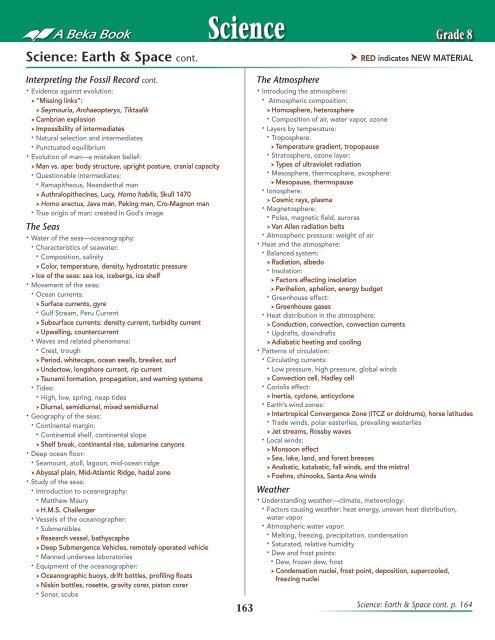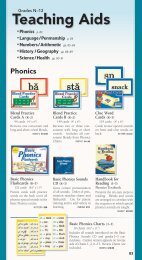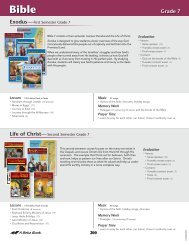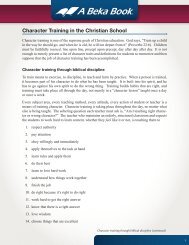Science & Health - A Beka Book
Science & Health - A Beka Book
Science & Health - A Beka Book
You also want an ePaper? Increase the reach of your titles
YUMPU automatically turns print PDFs into web optimized ePapers that Google loves.
<strong>Science</strong>: Earth & Space cont.<br />
Interpreting the Fossil Record cont.<br />
• Evidence against evolution:<br />
h “Missing links”:<br />
h Seymouria, Archaeopteryx, Tiktaalik<br />
h Cambrian explosion<br />
h Impossibility of intermediates<br />
• Natural selection and intermediates<br />
• Punctuated equilibrium<br />
• Evolution of man—a mistaken belief:<br />
h Man vs. ape: body structure, upright posture, cranial capacity<br />
• Questionable intermediates:<br />
• Ramapithecus, Neanderthal man<br />
h Authralopithecines, Lucy, Homo habilis, Skull 1470<br />
h Homo erectus, Java man, Peking man, Cro-Magnon man<br />
• True origin of man: created in God’s image<br />
The Seas<br />
• Water of the seas—oceanography:<br />
• Characteristics of seawater:<br />
• Composition, salinity<br />
h Color, temperature, density, hydrostatic pressure<br />
h Ice of the seas: sea ice, icebergs, ice shelf<br />
• Movement of the seas:<br />
• Ocean currents:<br />
h Surface currents, gyre<br />
• Gulf Stream, Peru Current<br />
h Subsurface currents: density current, turbidity current<br />
h Upwelling, countercurrent<br />
• Waves and related phenomena:<br />
• Crest, trough<br />
h Period, whitecaps, ocean swells, breaker, surf<br />
h Undertow, longshore current, rip current<br />
h Tsunami formation, propagation, and warning systems<br />
• Tides:<br />
• High, low, spring, neap tides<br />
h Diurnal, semidiurnal, mixed semidiurnal<br />
• Geography of the seas:<br />
• Continental margin:<br />
• Continental shelf, continental slope<br />
h Shelf break, continental rise, submarine canyons<br />
• Deep ocean floor:<br />
• Seamount, atoll, lagoon, mid-ocean ridge<br />
h Abyssal plain, Mid-Atlantic Ridge, hadal zone<br />
• Study of the seas:<br />
• Introduction to oceanography:<br />
• Matthew Maury<br />
h H.M.S. Challenger<br />
• Vessels of the oceanographer:<br />
• Submersibles<br />
h Research vessel, bathyscaphe<br />
h Deep Submergence Vehicles, remotely operated vehicle<br />
• Manned undersea laboratories<br />
• Equipment of the oceanographer:<br />
h Oceanographic buoys, drift bottles, profiling floats<br />
h Niskin bottles, rosette, gravity corer, piston corer<br />
• Sonar, scuba<br />
<strong>Science</strong><br />
163<br />
Grade 8<br />
h red indicates NeW MATerIAL<br />
The Atmosphere<br />
• Introducing the atmosphere:<br />
• Atmospheric composition:<br />
h Homosphere, heterosphere<br />
• Composition of air, water vapor, ozone<br />
• Layers by temperature:<br />
• Troposphere:<br />
h Temperature gradient, tropopause<br />
• Stratosphere, ozone layer:<br />
h Types of ultraviolet radiation<br />
• Mesosphere, thermosphere, exosphere:<br />
h Mesopause, thermopause<br />
• Ionosphere:<br />
h Cosmic rays, plasma<br />
• Magnetosphere:<br />
• Poles, magnetic field, auroras<br />
h Van Allen radiation belts<br />
• Atmospheric pressure: weight of air<br />
• Heat and the atmosphere:<br />
• Balanced system:<br />
h Radiation, albedo<br />
• Insolation:<br />
h Factors affecting insolation<br />
h Perihelion, aphelion, energy budget<br />
• Greenhouse effect:<br />
h Greenhouse gases<br />
• Heat distribution in the atmosphere:<br />
h Conduction, convection, convection currents<br />
• Updrafts, downdrafts<br />
h Adiabatic heating and cooling<br />
• Patterns of circulation:<br />
• Circulating currents:<br />
• Low pressure, high pressure, global winds<br />
h Convection cell, Hadley cell<br />
• Coriolis effect:<br />
h Inertia, cyclone, anticyclone<br />
• Earth’s wind zones:<br />
h Intertropical Convergence Zone (ITCZ or doldrums), horse latitudes<br />
• Trade winds, polar easterlies, prevailing westerlies<br />
h Jet streams, Rossby waves<br />
• Local winds:<br />
h Monsoon effect<br />
h Sea, lake, land, and forest breezes<br />
h Anabatic, katabatic, fall winds, and the mistral<br />
h Foehns, chinooks, Santa Ana winds<br />
Weather<br />
• Understanding weather—climate, meteorology:<br />
• Factors causing weather: heat energy, uneven heat distribution,<br />
water vapor<br />
• Atmospheric water vapor:<br />
• Melting, freezing, precipitation, condensation<br />
• Saturated, relative humidity<br />
• Dew and frost points:<br />
• Dew, frozen dew, frost<br />
h Condensation nuclei, frost point, deposition, supercooled,<br />
freezing nuclei<br />
<strong>Science</strong>: Earth & Space cont. p. 164

















